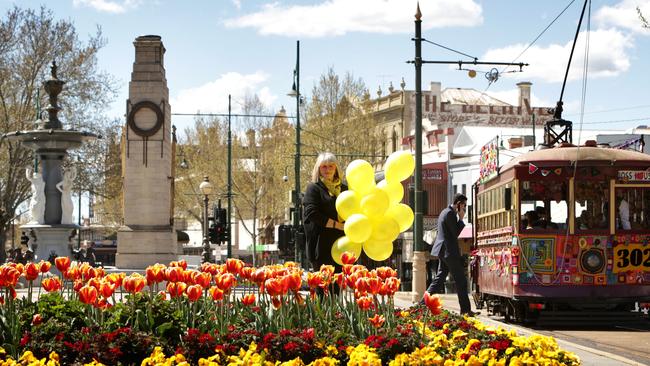Why Victoria’s regional cities are a great place to live
The liveability of Australia’s 21 biggest regional cities has been mapped for the first time and Ballarat, Bendigo and Geelong have come in among the nation’s best.

VIC News
Don't miss out on the headlines from VIC News. Followed categories will be added to My News.
The Victorian cities of Ballarat, Bendigo and Geelong have been rated among the nation’s most liveable regional centres.
But some have reached “tipping point” due to population growth, prompting calls from experts to limit expansion.
The liveability of Australia’s 21 biggest regional cities have been mapped for the first time, by RMIT researchers.
The data, from the university’s Centre for Urban Research, shows Ballarat has the best access to public transport and public open spaces.
Almost half of all homes in the Ballarat region are within 400m of train and bus services, and 58 per cent are within the same distance to a big open public space.
Ballarat also ranked in the top five regional cities for access to supermarkets, local jobs, services and housing affordability. Geelong and Bendigo also ranked high across the liveability measures.
The research was conducted over seven years and is based on seven liveability measures associated with health and wellbeing. They include walkability, access to public transport, large public open spaces, affordable housing and local employment.

The study also rates the proximity to liquor stores, which have a harmful impact on health.
Lead researcher Lucy Gunn said this first-time look at liveability outside Australia’s capital cities would be useful for planning.
“One of the key benefits of living in a regional city is that people tend to live close to where they work,” Dr Gunn said. “Ballarat and Bendigo performed well on this indicator, as well as access to public transport, which our research shows has major health and wellbeing benefits because it allows residents the opportunity to be more active.
“The benefit of looking at these liveability measures separately is you can see where each city is performing well and where improvements can be made.”
Dr Gunn warned some centres’ liveability was at risk due to steady growth on the outskirts. “Ballarat, Bendigo and other similar-sized regional cities are at a tipping point … they are starting to look like larger cities,” she said.
“Equitable access to key infrastructure such as public transport, healthy food and community services is better in central established areas. This declines as you move to the edge of the city (and) can impact health and wellbeing.”

Dr Gunn said it was crucial to avoid overexpansion.
“The good thing about our regional cities is there is still time to avoid the problems that come with our sprawling capital cities,” she said.
“There is an opportunity here for regional cities to capitalise on what makes them great and to recognise where they can improve to sustain liveability for years to come.”
BENDIGO
Public transport: 34 per cent of homes within 400m of buses and trains
Social infrastructure (childcare/healthcare facilities, schools, entertainment, etc):
Five out of 16 key destinations near homes
Supermarket: Homes 2154m on average from supermarkets
Alcohol: Homes 1264m on average from liquor stores
Public space: 42 per cent of homes within 400m of open space
Employment: 85 per cent have access to local jobs
Housing affordability: 32 per cent of households in the bottom 40 per cent of residences spend more than 30 per cent of household income on housing costs
GEELONG
Public transport: 38 per cent of homes within 400m of buses and trains
Social infrastructure: Six out of 16 key destinations near homes
Supermarket: Homes 1390m on average from supermarkets
Alcohol: Homes 1002m on average from liquor stores
Public space: 44 per cent of homes within 400m of an open space
Employment: 69 per cent have access to local jobs
Housing affordability: 32 per cent of households in the bottom 40 per cent
of residences spend more than 30 per cent of household income on housing costs
MORE NEWS
SHOPPING CENTRES URGE CUSTOMERS NOT TO STAY AWAY
PRICE RELIEF TIPPED AS GAS BAN LIFTED

